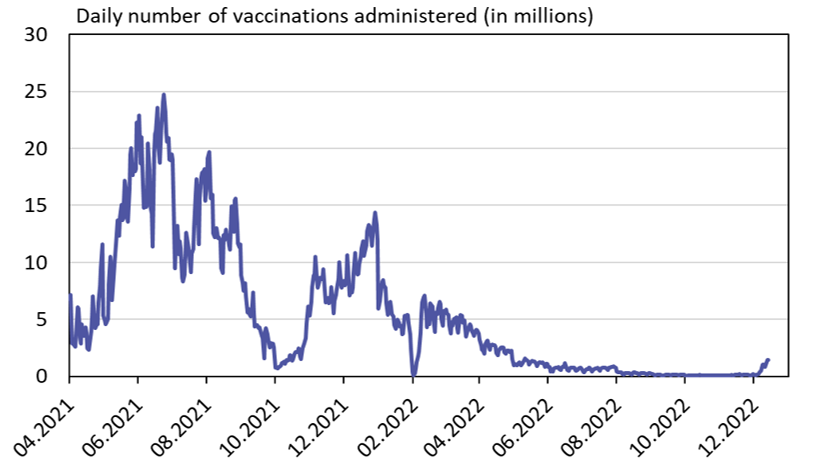BOFIT Weekly Review 50/2022
China abandons zero-covid policy
With China experiencing its largest covid wave ever, citizens took to the streets in late November to protest the hardships caused by the government’s strict zero-covid policies (BOFIT Weekly 48/2022). In the wake of exceptionally widespread protests, officials announced that they were significantly relaxing covid rules. Infected persons with mild cases can now recover at home, quarantine periods have been significantly shortened, covid testing has been reduced significantly, requirements for showing recent negative PCR test result to use regional public transport or enter public spaces has been eliminated, and the of sentry or venue scans for covid status has been eliminated. The phone app used to track people’s movements and covid exposures was decommissioned this week.
While it is hard to get a clear picture of the situation, the rapid about-turn in covid policy amidst China’s biggest covid surge ever has likely boosted the number of covid infections to levels never experienced in the country. Current statistical data are not comparable to earlier data as testing has been significantly curtailed and China has completely abandoned its efforts to track asymptomatic cases. Officials might also be under pressure to report lower infection rates and covid deaths than in actuality. Insurance companies have ceased to offer new covid insurances. The use of mandatory isolation and special covid quarantine sites is being adjusted in some cities to better treat the sick. Several media reports claim that the capacity of Beijing hospitals, which is already stretched, has been further burdened by increased numbers of hospital staff infected with covid. Due to the lack of staffing, infected doctors and nurses have been forced to remain on the job. Some cities report that fever-reducing medicines are in short supply.
The explosive spread of covid has many fearing that China’s healthcare system will be overwhelmed. China has limited bedspace in its hospitals, and even fewer intensive-care units relative to population, even if the immune protection from vaccines or having covid is still poor in the most at-risk groups. Officials last month promised to speed up vaccination of the elderly, but even a smooth-running vaccination campaign will take months given that China has 260 million people over the age of 60 and nearly 4o million people over 80. On Wednesday (Dec. 14), officials announced that person over 60 or otherwise belonging to an at-risk group are eligible for a covid booster shot. The vaccination protection of people under 60 has question marks too as many received their last vaccination shot last winter and since spring 2022 relatively few vaccinations have been administered. Moreover, the efficacy of covid vaccines developed in China is likely lower than that of vaccines used in the West, particularly mRNA vaccines.
China’s zero-covid policies have long been considered ineffective against the newer, more virulent strains of covid. In addition, massive-scale PCR testing, supervision, contact tracing and quarantining at sites outside the home has been extremely costly. Many local governments have now face a financial squeeze due to the government’s extreme suppression approach. However, China remains ill-prepared for opening up and its economy faces major uncertainty over the short-term.
Vaccine uptake in China has been quite low since spring 2022

Sources: National Health Commission of China, CEIC and BOFIT.